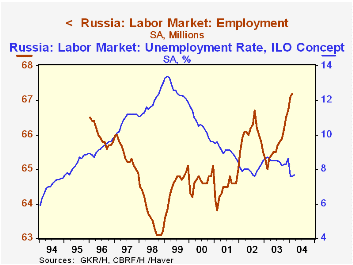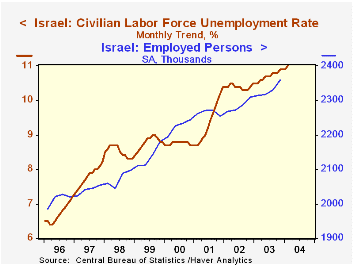 Global| Apr 22 2004
Global| Apr 22 2004Unemployment Rates on Varying Paths in Israel, Poland & Russia
Summary
Labor market conditions are mixed in three countries reporting data today. Unemployment rates are high and/or rising in Israel and Poland, but easing in Russia. At the same time, employment patterns don't necessarily match the [...]

Labor market conditions are mixed in three countries reporting data today. Unemployment rates are high and/or rising in Israel and Poland, but easing in Russia. At the same time, employment patterns don't necessarily match the behavior of the unemployment rate.
In Israel, unemployment is climbing gradually, with March's 11.0% rate the highest in the eight-year history of these data. This is accompanied by divergent trends in measures of employment. The number of employed persons, a quarterly series, has been rising, as indicated in the accompanying chart. But the number of jobs, both including and excluding those offered to Palestinian Authority workers, has been basically flat for the last couple of years.
In Poland, where unemployment is also rising, employment data are the mirror image, falling markedly, as might be expected and  generating the higher trend in unemployment. Notably, though, Poland's neighbors appear to be doing better, as employment in the Czech Republic is largely flat and mostly rising in Hungary and Slovakia.
generating the higher trend in unemployment. Notably, though, Poland's neighbors appear to be doing better, as employment in the Czech Republic is largely flat and mostly rising in Hungary and Slovakia.
Employment in Russia is also moving ahead, albeit somewhat erratically, while its unemployment rate is declining. Indeed, the progress in Russia looks favorable by other gauges as well, including production growth and GDP, with a distinct recovery evident beginning in 1999 after the country's plunge to debt default in 1998.
Yesterday, in this space, we cited evidence of the emergence of a broadening recovery in world trade. That should help jobs and unemployment conditions in many countries. Perhaps it's too early to expect this everywhere, but the mixed pattern in these countries today suggests that country-specific circumstances can get in the way, slowing desired improvements, even as neighboring nations do better.
| Percent | Mar | Feb | Jan | Year Ago | 2003 | 2002 | 2001 |
|---|---|---|---|---|---|---|---|
| Israel (NSA) | n.a. | 11.0 | 10.9 | 10.5 | 10.7 | 10.4 | 9.4 |
| Poland (SA) | 19.6 | 19.6 | 19.8 | 19.7 | 19.9 | 17.8 | 16.2 |
| Russia (SA) | 7.7 | 7.6 | 7.6 | 8.6 | 8.5 | 8.0 | 9.0 |
Carol Stone, CBE
AuthorMore in Author Profile »Carol Stone, CBE came to Haver Analytics in 2003 following more than 35 years as a financial market economist at major Wall Street financial institutions, most especially Merrill Lynch and Nomura Securities. She had broad experience in analysis and forecasting of flow-of-funds accounts, the federal budget and Federal Reserve operations. At Nomura Securities, among other duties, she developed various indicator forecasting tools and edited a daily global publication produced in London and New York for readers in Tokyo. At Haver Analytics, Carol was a member of the Research Department, aiding database managers with research and documentation efforts, as well as posting commentary on select economic reports. In addition, she conducted Ways-of-the-World, a blog on economic issues for an Episcopal-Church-affiliated website, The Geranium Farm. During her career, Carol served as an officer of the Money Marketeers and the Downtown Economists Club. She had a PhD from NYU's Stern School of Business. She lived in Brooklyn, New York, and had a weekend home on Long Island.





